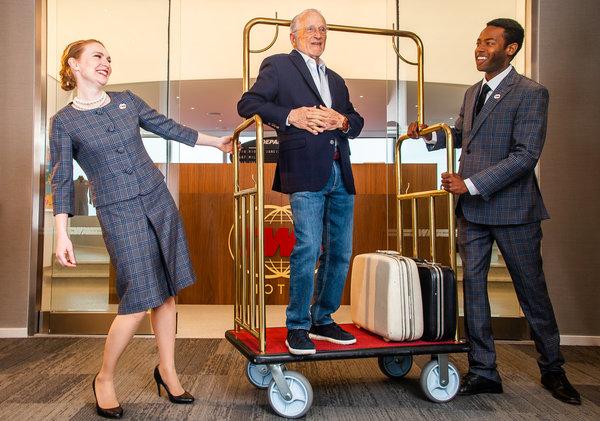
Stan Herman, center, designed uniforms for the staff at the new T.W.A. hotel, modeled here.CreditIsak Tiner for The New York Times
Is it possible that Kennedy Airport is going to be fashionable again?
Given that J.F.K. is often voted among the worst airports in the United States; given the fraught state of many airlines today, what with Boeing’s safety concerns and the Wow Air bankruptcy; and given the general malaise around air travel as an experience to be endured, preferably with the help of some Ambien, rather than enjoyed, it’s hard to imagine.
And yet designers are casting their eyes, not skyward necessarily, but to a long-abandoned terminal in the heart of Kennedy Airport, the transformation of which could (maybe, possibly, if they have anything to do with it) change the image of the much-derided port of entry.
The terminal in question is the old T.W.A. Flight Center, designed by the Finnish architect Eero Saarinen in 1962 to sit like a bewinged white U.F.O. amid the tarmac. Closed since 2001, it was a ghostly relic of space-age architecture. In 2016, the Port Authority granted the developer MCR/Morse the rights to restore it to period glory.
In May it will reopen as a 512-room hotel replete with the kind of time-traveling touches, including Knoll furniture, a sunken lounge bar and rotary phones in every room, that generally serve as Pavlovian bells for the style-minded.
No wonder Louis Vuitton announced that it would hold its resort show — which has in the past taken place at the I.M. Pei-designed Miho Museum in Kyoto, Japan, and the Oscar Niemeyer-designed Niterói Contemporary Art Museum in Niterói, Brazil — in the hotel on May 8.
The following week, when the hotel officially opens, guests will find themselves met by “greeters” in T.W.A. uniforms of yesteryear by designers like Valentino, Ralph Lauren and Oleg Cassini (just in case anyone needs reminding that once upon a time even the most haute designers saw the aisle as a potential catwalk).
After they make it past the greeters, guests will find themselves amid various employees in uniforms created by Stan Herman, the longest serving president of the Council of Fashion Designers of America (from 1991 to 2006), whose 90th birthday party was recently hosted by Donna Karan.
As far as seals of approval go, this is like having the godfather give you his blessing — if the godfather was a grizzled and unassuming man who helped shape the New York fashion world.
“They approached me around 2015, 2016,” Mr. Herman said of how he got involved with the project. As he spoke, he was sitting at a Saarinen tulip table in the T.W.A. lounge on the 86th floor of One World Trade Center, a space set up by MCR/Morse to show off the project. From the floor-to-ceiling windows, you could see the white blob far in the distance that was the hotel.
“They were all excited because they wanted the operation to look very ’60s, and they’d found someone who was there,” he said.
Or almost there. Aside from being known as the “father of fashion week,” Mr. Herman may also be the most famous ready-to-wear designer to trade the runway for the uniform world. He said he made his first uniform for T.W.A. in 1974, which was one year after he started making uniforms for Avis.
He has also worked with, among others, FedEx (where he is still creative consultant), McDonald’s, the Loews hotel chain, Amtrak, Eastern Airlines, US Airways and JetBlue, with whom he is still involved. He has dressed hundreds of thousands of people.
“I’m a people’s designer,” Mr. Herman said. “I’ve always been a people’s designer. And for that it doesn’t get better than uniforms, as far as I’m concerned.”
“The airline uniform that was the most memorable was Pan Am,” he said. “The Pan Am blue was perfect branding. They stuck to the same color for years and years and years. T.W.A. had a completely different attitude. It was amazing what they let designers do. Once they told me the colors, they let me go any direction I wanted.”
The first direction he went, in 1974, was sort of YSL meets Danskin: a bright red safari jacket and matching skirt, a blue ribbed tee and shirt, and a denim halter shirtdress over a ribbed tee and wide khaki pants. For the hotel, though, it’s very “Mad Men.”
“We decided everything should be plaid,” Mr. Herman said. “Plaid vest, plaid jacket, plaid pants for the guys; a cropped jacket with big Jackie O buttons and a box-pleat skirt for the women.” The back-of-house outfits are also on-theme: red and blue bowling shirt for men and tunic-like camp shirts for women. “It looks jaunty,” Mr. Herman said.
It also fits with the time warp that is the hotel’s aesthetic. As Tyler Brûlé, the editor of Monocle and something of an air-travel obsessive, said, air travel has become so deglamorized that whenever anybody tries to frame it in a positive light, they are forced to look back.
But while the results have an old-fashioned eye-candy appeal, they don’t necessarily do much to move things forward.
Mr. Herman points out, however, that, like the 1950s Western Electric phones in the rooms, which have been retrofitted with a pulse-to-tone converter, the clothes have been modernized, thanks to stretch technology and the fact that they come in sizes 0 to 22.
“It’s going to set a new precedent,” he said. “It’s going to be fun.”
So is a collection of T.W.A. merch, inspired in part by the uniforms, the logo and the aesthetic, and created under the auspices of another fashion-world stalwart: Somsack Sikhounmuong, the designer of Alex Mill and a former designer for J. Crew and Madewell.
The goods will include cashmere sweatshirts and sneakers with the logo on the side that, said Tyler Morse, the chief executive of MCR/Morse, “you can’t get anywhere else.” After the Stan Smith, the T.W.A.? It’s a moonshot, of sorts.







